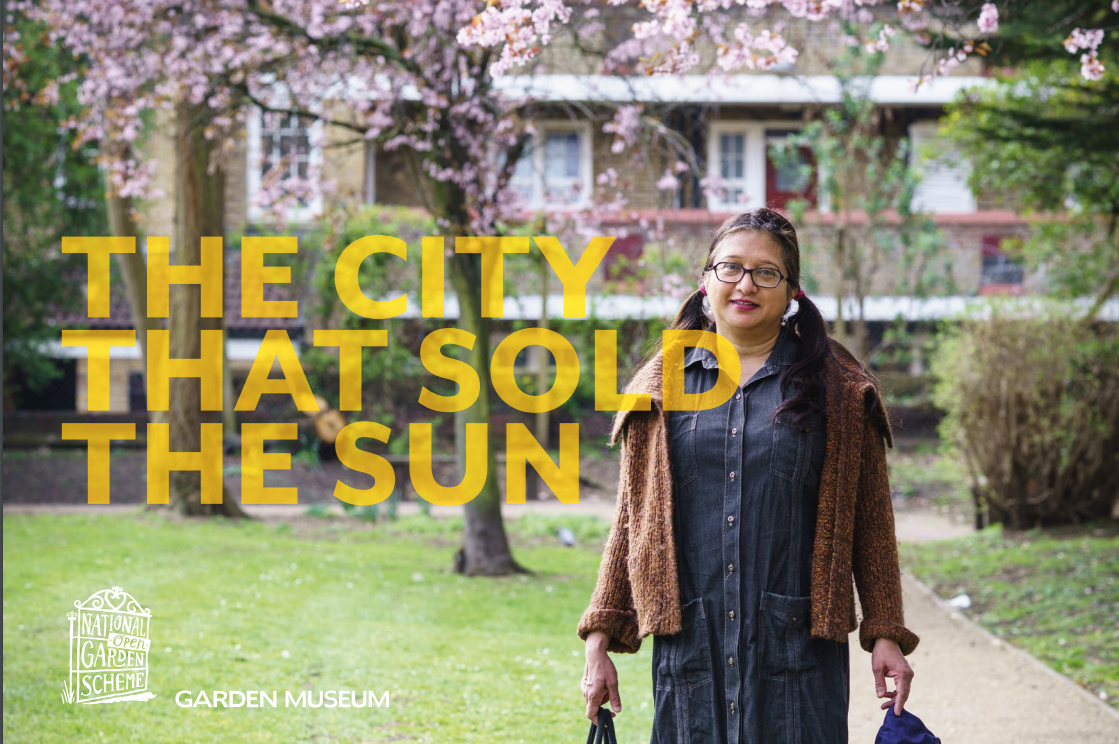The City That Sold the Sun

The National Garden Scheme has funded the publication of a new report in support of The City That Sold The Sun the Garden Museum’s campaign calling to keep the sun shining in our green spaces for a minimum of six hours.
PRESS RELEASE
Today (21st March 2022), the spring equinox, the Garden Museum releases its publication The City that Sold the Sun, as part of its campaign [1] to protect outdoor spaces from overshadowing by tall buildings. The GLA’s policy proposes that as measured on 21st March each year two hours of direct sunlight is enough for a park, playground or wildlife area. For the remaining twenty-two hours a park can be in shadow, or in darkness, on 21st March each year.
In The City That Sold the Sun, the Garden Museum asks that this two-hour rule to be changed to a minimum of six hours to ensure that every Londoner has access to sunlight in their local green space before this guidance is set in stone in Good Quality Homes for All Londoners. The City That Sold the Sun has been funded by the National Garden Scheme [2], and includes contributions from psychiatrist, psychotherapist, and author Dr Sue Stuart-Smith; Director of Policy & Research at London Wildlife Trust Mathew Frith; Professor and GP Sir Sam Everington and the Garden Museums’ Science Learning Officer Samia Qureshi.
Current planning policy for London [3] requires just TWO hours of direct sunlight on a park, playground or wildlife area on the two annual equinoxes of 21st March and 21st September. This permits any outdoor space to be in total darkness for 22 hours every day for six months of the year In mid-winter, when the sun is even lower, parks and playgrounds can be in permanent shadow – and still meet current guidelines.
This two-hour rule is incorporated into the current draft of the supplementary planning guidance (SPG) Good Quality Homes For All Londoners, which will set out where and how new housing should be built in London. The SPG is integral to the Mayor of London’s new London Plan, which is due to replace the current plan this year.
Christopher Woodward, Director of the Garden Museum said: “We think of planning battles in terms of bricks and mortar, or the preservation of green space. But a new battle is taking place: a battle for the sky. And every time a skyscraper is built, a piece of the sky is sold for ever. London is getting darker. For ever.”
“We want to see current BRE guidelines changed from two hours to six for the parks, playgrounds, and wildlife reserves of London, for the benefit of its people, plants, and pollinators.”
A lack of sunlight in urban environments has direct consequences for our health, as well as the impact it has on green space. Professor Dr Sir Sam Everington is concerned about the return of vitamin D deficiency, something due almost entirely to lifestyle and the built environment.
Professor Dr Sir Sam Everington, Tower Hamlets GP and co-author of the publication said: “The consequences of a vitamin D deficiency are very clear. At the less extreme end it causes muscle weakness and aches, and at the more extreme end, it causes rickets. You wouldn’t expect to see it in the modern world, certainly not in the UK. One of many eradicated diseases returning due almost entirely to lifestyle and the built environment.
“Half of children in Tower Hamlets have low vitamin D. We need to have children in the playground for at least half an hour a day, ideally one hour.”
London Assembly member Sian Berry said: “Nobody should have to live their lives shadowed in permanent gloom. Last year, the London Assembly voted unanimously in favour of my motion further cementing the crucial importance of daylight to healthy homes[4]. “The Mayor told me he has ‘no intention whatsoever of reducing the daylight and sunlight standards’, however, the updated Good Quality Homes for All Londoners guidance has yet to be published. Time has not been called on these threats to Londoners’ access to sunlight.
“Daylight and thriving natural green spaces are essential to Londoners; both are vital for their physical and mental wellbeing. In the wake of the coronavirus pandemic, we should be using planning rules to expand these benefits, not putting a stopwatch on them.”
The campaign is supported by London Skyline Campaign, SAVE Britain’s Heritage, Stop the Blocks, the London Gardens Trust, Lambeth Village, London Wildlife Trust and the Metropolitan Parks and Gardens Association.
READ THE REPORT HERE The City That Sold The Sun (1)
Notes to Editors:
[1] Garden Museum petition ‘Six hours’ sunlight for parks, playgrounds and wildlife’ Petition · Six hours’ sunlight for parks, playgrounds and wildlife · Change.org
[2] The City That Sold the Sun has been funded by the National Garden Scheme https://ngs.org.uk/
[3] The BRE Guidelines can be read in full here:BRE-Oct-2011-Site-layout-planning-for-Daylight-and-sunlight.pdf (reading.gov.uk)
[4] Let there be light! Ensure green spaces have six hours of daylight, 10 June 2021: Let there be light! Ensure green spaces have six hours of daylight | London City Hall
For press enquires or a copy of the publication please contact:
George Hudson, Green London Curator, Garden Museum
[email protected]


















